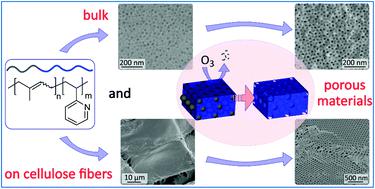当前位置:
X-MOL 学术
›
Polym. Chem.
›
论文详情
Our official English website, www.x-mol.net, welcomes your feedback! (Note: you will need to create a separate account there.)
A block copolymer templated approach for the preparation of nanoporous polymer structures and cellulose fiber hybrids by ozone treatment
Polymer Chemistry ( IF 4.6 ) Pub Date : 2022-06-14 , DOI: 10.1039/d2py00562j Lea Gemmer 1 , Qiwei Hu 2, 3 , Bart-Jan Niebuur 4 , Tobias Kraus 4, 5 , Bizan N. Balzer 2, 3, 6 , Markus Gallei 1, 7
Polymer Chemistry ( IF 4.6 ) Pub Date : 2022-06-14 , DOI: 10.1039/d2py00562j Lea Gemmer 1 , Qiwei Hu 2, 3 , Bart-Jan Niebuur 4 , Tobias Kraus 4, 5 , Bizan N. Balzer 2, 3, 6 , Markus Gallei 1, 7
Affiliation

|
Functional amphiphilic block copolymers (BCPs) are versatile, smart, and promising materials that are often used as soft templates in nanoscience. BCPs generally feature the capability of microphase-separation leading to various interesting morphologies at the nanometer length scale. Materials derived from BCPs can be converted into porous structures while retaining the underlying morphology of the matrix material. Here, a convenient and scalable approach for the fabrication of porous functional polyvinylpyridines (P2VP) is introduced. The BCP polyisoprene-block-P2VP (PI-b-P2VP) is obtained via sequential anionic polymerization of the respective monomers and used to form either BCP films in the bulk state or a soft template in a composite with cellulose fibers. Cross-linking of the BCPs with 1,4-diiodobutane is conducted and subsequently PI domains are selectively degraded inside the materials using ozone, while preserving the porous and tailor-made P2VP nanostructure. Insights into the feasibility of the herein presented strategy is supported by various polymer characterization methods comprising nuclear magnetic resonance (NMR), size exclusion chromatography (SEC), and differential scanning calorimetry (DSC). The resulting bulk- and composite materials are investigated regarding their morphology and pore formation by scanning electron microscopy (SEM), atomic force microscopy (AFM) and small-angle X-ray scattering (SAXS). Furthermore, chemical conversions were examined by energy dispersive X-ray spectroscopy (EDS), attenuated total reflection Fourier-transformation infrared spectroscopy (ATR-FTIR) and water contact angle (WCA) measurements. By this convenient strategy the fabrication of functional porous P2VP in the bulk state and also within sustainable cellulose composite materials is shown, paving the synthetic strategy for the generation of a new family of stimuli-responsive sustainable materials.
中文翻译:

通过臭氧处理制备纳米多孔聚合物结构和纤维素纤维杂化物的嵌段共聚物模板方法
功能性两亲嵌段共聚物 (BCP) 是多功能、智能且有前途的材料,通常用作纳米科学中的软模板。BCPs 通常具有微相分离的能力,导致纳米长度尺度上的各种有趣的形态。衍生自 BCP 的材料可以转化为多孔结构,同时保留基体材料的基本形态。在这里,介绍了一种用于制造多孔功能性聚乙烯基吡啶 (P2VP) 的方便且可扩展的方法。BCP 聚异戊二烯-嵌段-P2VP (PI- b -P2VP)通过以下方式获得各个单体的顺序阴离子聚合,用于形成本体状态的 BCP 薄膜或与纤维素纤维复合的软模板。进行 BCP 与 1,4-二碘丁烷的交联,随后使用臭氧在材料内部选择性降解 PI 域,同时保留多孔和定制的 P2VP 纳米结构。包括核磁共振 (NMR)、尺寸排阻色谱 (SEC) 和差示扫描量热法 (DSC) 在内的各种聚合物表征方法支持对本文提出的策略的可行性的深入了解。通过扫描电子显微镜 (SEM)、原子力显微镜 (AFM) 和小角 X 射线散射 (SAXS) 研究所得块状和复合材料的形态和孔形成。此外,通过能量色散 X 射线光谱 (EDS)、衰减全反射傅里叶变换红外光谱 (ATR-FTIR) 和水接触角 (WCA) 测量来检查化学转化。通过这种方便的策略,展示了在块状状态以及可持续纤维素复合材料中制造功能性多孔 P2VP,为生成新的刺激响应可持续材料家族铺平了合成策略。
更新日期:2022-06-14
中文翻译:

通过臭氧处理制备纳米多孔聚合物结构和纤维素纤维杂化物的嵌段共聚物模板方法
功能性两亲嵌段共聚物 (BCP) 是多功能、智能且有前途的材料,通常用作纳米科学中的软模板。BCPs 通常具有微相分离的能力,导致纳米长度尺度上的各种有趣的形态。衍生自 BCP 的材料可以转化为多孔结构,同时保留基体材料的基本形态。在这里,介绍了一种用于制造多孔功能性聚乙烯基吡啶 (P2VP) 的方便且可扩展的方法。BCP 聚异戊二烯-嵌段-P2VP (PI- b -P2VP)通过以下方式获得各个单体的顺序阴离子聚合,用于形成本体状态的 BCP 薄膜或与纤维素纤维复合的软模板。进行 BCP 与 1,4-二碘丁烷的交联,随后使用臭氧在材料内部选择性降解 PI 域,同时保留多孔和定制的 P2VP 纳米结构。包括核磁共振 (NMR)、尺寸排阻色谱 (SEC) 和差示扫描量热法 (DSC) 在内的各种聚合物表征方法支持对本文提出的策略的可行性的深入了解。通过扫描电子显微镜 (SEM)、原子力显微镜 (AFM) 和小角 X 射线散射 (SAXS) 研究所得块状和复合材料的形态和孔形成。此外,通过能量色散 X 射线光谱 (EDS)、衰减全反射傅里叶变换红外光谱 (ATR-FTIR) 和水接触角 (WCA) 测量来检查化学转化。通过这种方便的策略,展示了在块状状态以及可持续纤维素复合材料中制造功能性多孔 P2VP,为生成新的刺激响应可持续材料家族铺平了合成策略。



























 京公网安备 11010802027423号
京公网安备 11010802027423号